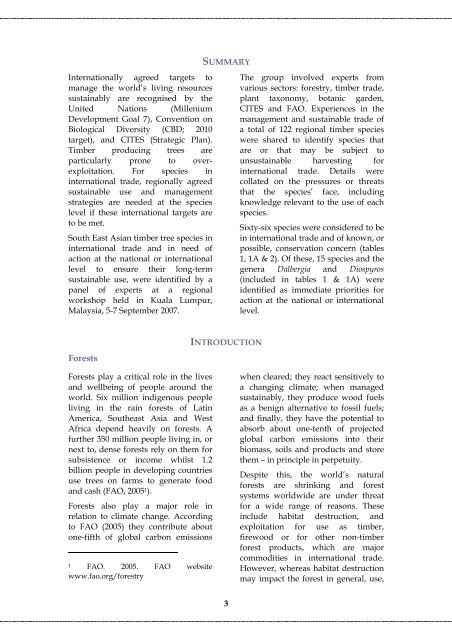strategies for the sustainable use and management of timber tree ...
strategies for the sustainable use and management of timber tree ...
strategies for the sustainable use and management of timber tree ...
You also want an ePaper? Increase the reach of your titles
YUMPU automatically turns print PDFs into web optimized ePapers that Google loves.
SUMMARY<br />
Internationally agreed targets to<br />
manage <strong>the</strong> world’s living resources<br />
sustainably are recognised by <strong>the</strong><br />
United Nations (Millenium<br />
Development Goal 7), Convention on<br />
Biological Diversity (CBD; 2010<br />
target), <strong>and</strong> CITES (Strategic Plan).<br />
Timber producing <strong>tree</strong>s are<br />
particularly prone to overexploitation.<br />
For species in<br />
international trade, regionally agreed<br />
<strong>sustainable</strong> <strong>use</strong> <strong>and</strong> <strong>management</strong><br />
<strong>strategies</strong> are needed at <strong>the</strong> species<br />
level if <strong>the</strong>se international targets are<br />
to be met.<br />
South East Asian <strong>timber</strong> <strong>tree</strong> species in<br />
international trade <strong>and</strong> in need <strong>of</strong><br />
action at <strong>the</strong> national or international<br />
level to ensure <strong>the</strong>ir long-term<br />
<strong>sustainable</strong> <strong>use</strong>, were identified by a<br />
panel <strong>of</strong> experts at a regional<br />
workshop held in Kuala Lumpur,<br />
Malaysia, 5-7 September 2007.<br />
The group involved experts from<br />
various sectors: <strong>for</strong>estry, <strong>timber</strong> trade,<br />
plant taxonomy, botanic garden,<br />
CITES <strong>and</strong> FAO. Experiences in <strong>the</strong><br />
<strong>management</strong> <strong>and</strong> <strong>sustainable</strong> trade <strong>of</strong><br />
a total <strong>of</strong> 122 regional <strong>timber</strong> species<br />
were shared to identify species that<br />
are or that may be subject to<br />
un<strong>sustainable</strong> harvesting <strong>for</strong><br />
international trade. Details were<br />
collated on <strong>the</strong> pressures or threats<br />
that <strong>the</strong> species’ face, including<br />
knowledge relevant to <strong>the</strong> <strong>use</strong> <strong>of</strong> each<br />
species.<br />
Sixty-six species were considered to be<br />
in international trade <strong>and</strong> <strong>of</strong> known, or<br />
possible, conservation concern (tables<br />
1, 1A & 2). Of <strong>the</strong>se, 15 species <strong>and</strong> <strong>the</strong><br />
genera Dalbergia <strong>and</strong> Diospyros<br />
(included in tables 1 & 1A) were<br />
identified as immediate priorities <strong>for</strong><br />
action at <strong>the</strong> national or international<br />
level.<br />
Forests<br />
INTRODUCTION<br />
Forests play a critical role in <strong>the</strong> lives<br />
<strong>and</strong> wellbeing <strong>of</strong> people around <strong>the</strong><br />
world. Six million indigenous people<br />
living in <strong>the</strong> rain <strong>for</strong>ests <strong>of</strong> Latin<br />
America, Sou<strong>the</strong>ast Asia <strong>and</strong> West<br />
Africa depend heavily on <strong>for</strong>ests. A<br />
fur<strong>the</strong>r 350 million people living in, or<br />
next to, dense <strong>for</strong>ests rely on <strong>the</strong>m <strong>for</strong><br />
subsistence or income whilst 1.2<br />
billion people in developing countries<br />
<strong>use</strong> <strong>tree</strong>s on farms to generate food<br />
<strong>and</strong> cash (FAO, 2005 1 ).<br />
Forests also play a major role in<br />
relation to climate change. According<br />
to FAO (2005) <strong>the</strong>y contribute about<br />
one-fifth <strong>of</strong> global carbon emissions<br />
1 FAO. 2005. FAO website<br />
www.fao.org/<strong>for</strong>estry<br />
when cleared; <strong>the</strong>y react sensitively to<br />
a changing climate; when managed<br />
sustainably, <strong>the</strong>y produce wood fuels<br />
as a benign alternative to fossil fuels;<br />
<strong>and</strong> finally, <strong>the</strong>y have <strong>the</strong> potential to<br />
absorb about one-tenth <strong>of</strong> projected<br />
global carbon emissions into <strong>the</strong>ir<br />
biomass, soils <strong>and</strong> products <strong>and</strong> store<br />
<strong>the</strong>m – in principle in perpetuity.<br />
Despite this, <strong>the</strong> world’s natural<br />
<strong>for</strong>ests are shrinking <strong>and</strong> <strong>for</strong>est<br />
systems worldwide are under threat<br />
<strong>for</strong> a wide range <strong>of</strong> reasons. These<br />
include habitat destruction, <strong>and</strong><br />
exploitation <strong>for</strong> <strong>use</strong> as <strong>timber</strong>,<br />
firewood or <strong>for</strong> o<strong>the</strong>r non-<strong>timber</strong><br />
<strong>for</strong>est products, which are major<br />
commodities in international trade.<br />
However, whereas habitat destruction<br />
may impact <strong>the</strong> <strong>for</strong>est in general, <strong>use</strong>,<br />
3

















